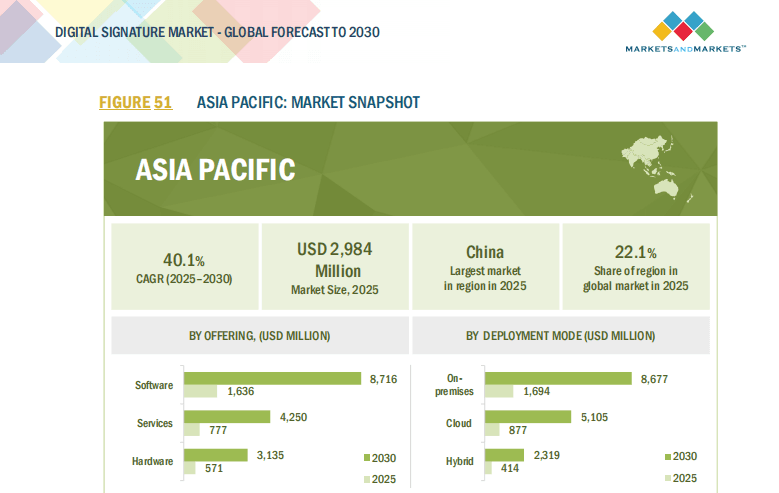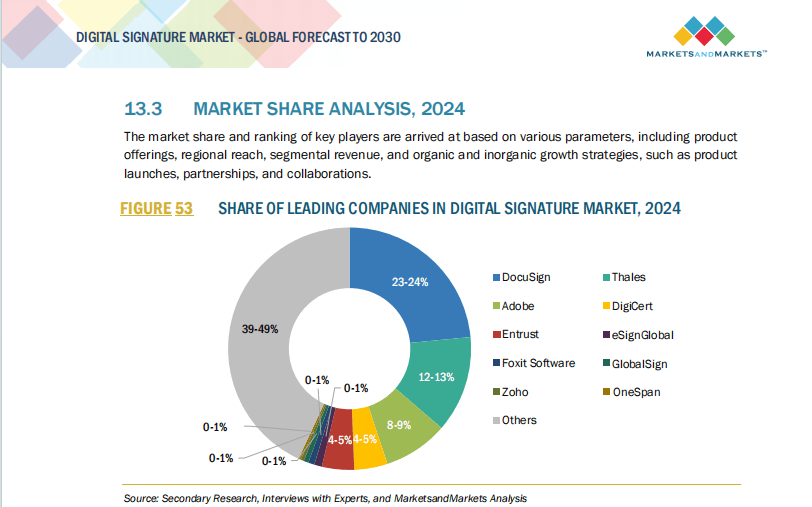WhatsApp or email with our sales team or get in touch with a business development professional in your region.
Asia-Pacific: The New Powerhouse in Digital Signatures





The Asia-Pacific (APAC) region is rapidly emerging as one of the most important growth engines in the global digital signature market. According to research published by MarketsandMarkets, APAC is projected to maintain a compound annual growth rate (CAGR) of 40.1% between 2025 and 2030, with market size expanding from USD 2.984 billion in 2025 to USD 16.1 billion in 2030. This growth rate not only surpasses that of mature markets like North America and Europe but also highlights the speed and scale of digital transformation across the region.

From China and Japan to India and Southeast Asia, economies in APAC vary significantly in digital infrastructure maturity, regulatory frameworks, and business ecosystems, yet share a common trajectory: enterprises and governments are accelerating the adoption of digital signature technology as a critical component of the digital economy. In particular, China has established a robust regulatory system, underpinned by the Electronic Signature Law and CA infrastructure, making it one of the most active markets globally. India’s Aadhaar digital identity program has provided a strong foundation for authentication services, while Southeast Asian nations such as Singapore and Malaysia are leading initiatives for cross-border regulatory alignment, reducing friction in international trade.
For example, eSignGlobal ranked first in market share in the Asia-Pacific region and sixth globally in the report, marking the first time a company from Asia has been included in the global top 10.

Three primary drivers fuel APAC’s market expansion. First, a massive base of mobile internet users and high-volume online transactions provides a natural use case for e-signatures. Countries such as China, India, and Indonesia have thriving e-commerce and fintech ecosystems that normalize digital contracts in daily life. Second, regulatory improvements inspire confidence in the legality and security of digital signatures. Singapore’s standards for electronic certification are globally recognized, and Japan and Korea are working to align their systems with international frameworks like eIDAS. Third, enterprise demand is rising sharply, as multinational corporations prioritize APAC for strategic growth, driving digitization across contract management, supply chain financing, and cross-border payment operations.
Technological innovation is another significant factor. Local vendors are advancing security architecture and mobile-first solutions, often integrating hardware security modules (HSMs) and biometric authentication for high-security sectors such as banking and government. APAC countries are also experimenting with blockchain notarization, smart contracts, and identity verification systems, paving the way for sophisticated use cases. The complexity of cross-border compliance in this region has also prompted investments in hybrid cloud deployment and multi-region data centers to meet regulatory requirements in multiple jurisdictions.
The competitive landscape in APAC is dynamic. While international giants maintain strong market positions, local players are rapidly gaining ground through tailored services and localized innovation. For example, Chinese e-signature providers have deep expertise in regulatory compliance and customer workflows within their domestic market, while startups in India and Southeast Asia focus on delivering lightweight SaaS solutions for SMEs. This has created a three-tier competitive structure in APAC: global brands, regional leaders, and vertical innovators.
The region’s diversity and fragmentation present challenges but also opportunities. Vendors must navigate a patchwork of data protection, identity verification, and e-signature regulations, requiring highly adaptable compliance solutions. Additionally, cultural and linguistic diversity emphasizes the importance of localized user experiences. Providers capable of delivering seamless integration across multiple languages, currencies, and workflows are poised to thrive.
Over the next three to five years, APAC is expected to remain the world’s fastest-growing e-signature market and serve as a testing ground for innovation. Growth in cross-border trade, digital government initiatives, and fintech adoption will expand e-signature use cases, while rising demand for security, scalability, and intelligence will accelerate technological advancement. From an industry chain perspective, e-signatures are becoming a key connector in the digitalization of identity, contracts, and payments, solidifying their role as a trust hub that links enterprises, users, and regulators.
References: MarketsandMarkets “Digital Signature Market Global Forecast to 2030”, Fortune Business Insights, public regulatory documents from APAC countries.

Shunfang
Head of Product Management at eSignGlobal, a seasoned leader with extensive international experience in the e-signature industry.
Follow me on LinkedIn
Get legally-binding eSignatures now!
30 days free fully feature trial
Business Email
Get Started
 Only business email allowed
Only business email allowed
Latest Articles


